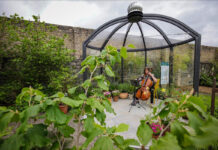Alberto Ramos Luz assesses the most important physiological and environmental factors impacting apple size.
Apple fruit size is an important factor from a commercial point of view. Medium and large fruits are usually more valued than small fruits.
There are several factors that influence the growth and development of fruits, including genetic, cultural and environmental factors. Aspects of these can be altered to favour fruit growth. Therefore, it is important to understand how fruit growth occurs physiologically, as well as the factors that can interfere in this process.
PHYSIOLOGY OF FRUIT GROWTH
Fruit growth occurs from the time of fruit set until fruit harvest. Physiologically, the fruit grows in two ways, by increasing the number of cells, and by increasing the size of the cells.
In general, apples grow through cell division in the first 40-50 days after full bloom, this moment being essential for determining the final growth potential of the fruit.
In cases of stress in this first phase of growth, a reduced number of cells are formed and, even with later optimal development conditions, the fruit does not reach its full size potential.
The first phase of growth is commonly impaired by water stress, and by crop-load excess due to lack of thinning, inadequate thinning or late thinning (see photos on this page).
The second phase of growth occurs by cell expansion. While cell division occurs predominantly by the action of the plant hormone cytokinin, cell expansion occurs predominantly by gibberellins. This phase is longer, and if the fruit has a high number of cells, the delay in growth due to some stress in the cell expansion phase can be compensated for later. This does not occur in the cell division phase.
FACTORS THAT INTERFERE WITH FRUIT GROWTH
There are several factors that interfere with the division and cellular expansion of the fruits. Three factors of particular note are the genetic characteristics of the cultivars, the crop load, and the interception and distribution of solar radiation in the canopy of the tree.
The number of seeds, rootstock, position of the fruit in the inflorescence, and type of productive structure also have an effect on fruit growth. The greater the number of seeds, the greater the potential for fruit growth; therefore, pollination plays an important role in fruit set and fruit growth.
The fruit in the central position of the cluster, coming from the ‘queen flower’, has greater growth potential compared to the others. Terminal fruits have greater growth potential than spur fruits, as they have a larger leaf area and, consequently, greater photosynthetic capacity.
Fruit growth can be limited by the availability of water and nutrients, and by any factors that affect photosynthesis, such as low temperatures, high cloud cover, and leaf injuries by insects and/or diseases, amongst other risks.
Higher temperatures, and higher thermal amplitudes and solar radiation, favour fruit growth.
PLANT-GROWTH REGULATORS (PGRs) TO MAXIMISE FRUIT GROWTH
The application of plant-growth regulators (PGRs) – based on growth-promoting hormones, as well as photosynthetic inhibitors – has been studied, with the aim of managing the crop load by fruit thinning, thereby increasing fruit size through an increase in the supply of carbohydrates to the remaining fruits.
Some of the same PGRs used for chemical thinning in apples can be used in smaller doses without a thinning effect, but with the potential to modify the cellular composition of the fruits, enhancing fruit growth.
In a study conducted by Pereira (2020) on ‘Maxi Gala’ apple trees in Southern Brazil, it was found that the application of the cytokinins benzyladenine (6BA) and thidiazuron (TDZ) provides a greater number of cells and smaller intercellular spaces when applied at pink bud (BBCH57) and full bloom (BBCH65) stages.
TDZ 20mg/L-1 at pink bud and full bloom induces greater cell division in the fruits, providing a greater number of smaller cells. The application of 6BA 10mg/L-1 at pink bud and full bloom forms larger cells, in sufficient amounts to reduce the intercellular spaces.
FRUIT CELLULAR BEHAVIOUR AND STORAGE POTENTIAL
The number and size of cells are not only important in determining the final size of the fruit, but also in determining its post-harvest storage potential.
Fruits with a greater number of cells, smaller intercellular spaces and small cell size are desirable, as they have greater flesh firmness. They also have lower risk of physiological disorders due to calcium deficiency, and greater storage potential due to reduced flesh-firmness loss during refrigerated storage, as found by Pereira (2020) in the study mentioned above.
In the images above, it is possible to observe different cellular behaviour in young ‘Maxi Gala’ apple fruits. The fruit in the upper image has greater potential for growth and superior quality compared to the fruit in the lower image.
FINAL REMARKS
Fruit growth is influenced by several factors, such as cultural practices that alter the source/sink relationship; that prioritise the carbohydrate partition for the fruits; and that alter the hormonal balance (mainly the cytokinin base applied in the cell division phase).
The best tools that fruit growers can use to obtain the best possible economic outcome are the following: precision crop-load management through precision pruning, leaving the right amount of flower buds per tree; chemical thinning and hand thinning, leaving the right amount of fruits per tree; and the use of PGRs to increase fruit size, or even to increase the return bloom.
The use of an irrigation system is also a great tool to avoid reduced fruit growth due to water deficit. ✽
ALBERTO RAMOS LUZ is a research officer in the Horticulture Development Department in Teagasc, based in Oak Park, Co Carlow. Alberto is leading research projects to support the development of the apple-growing industry in Ireland. He can be contacted at Horticulture Development Department, Teagasc Oak Park, Co Carlow or alberto.ramosluz@teagasc.ie.







